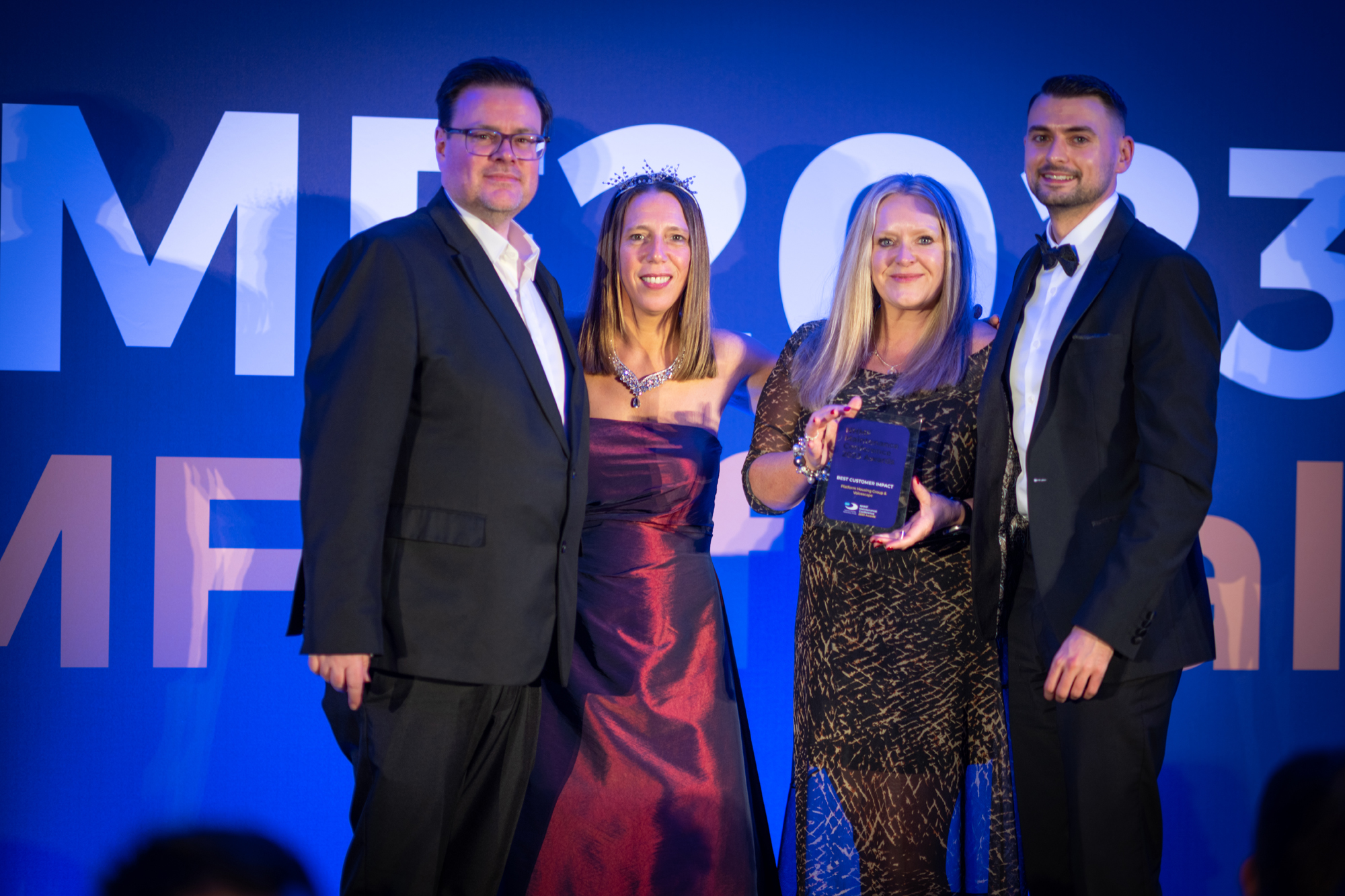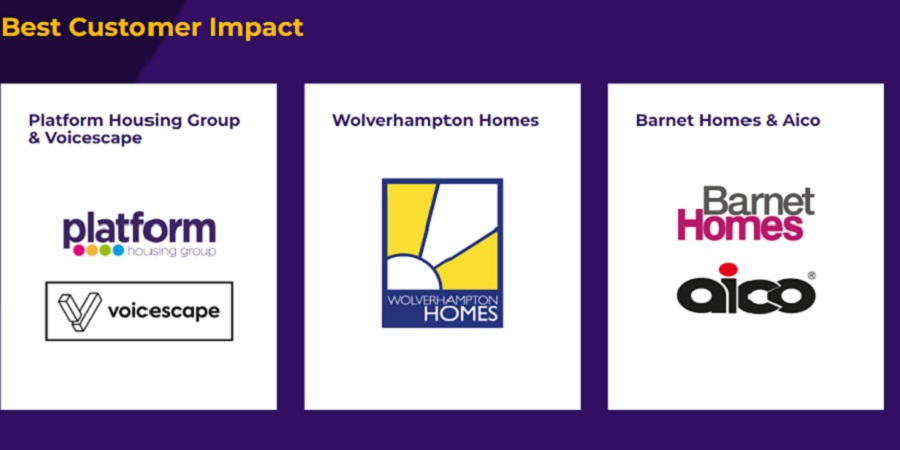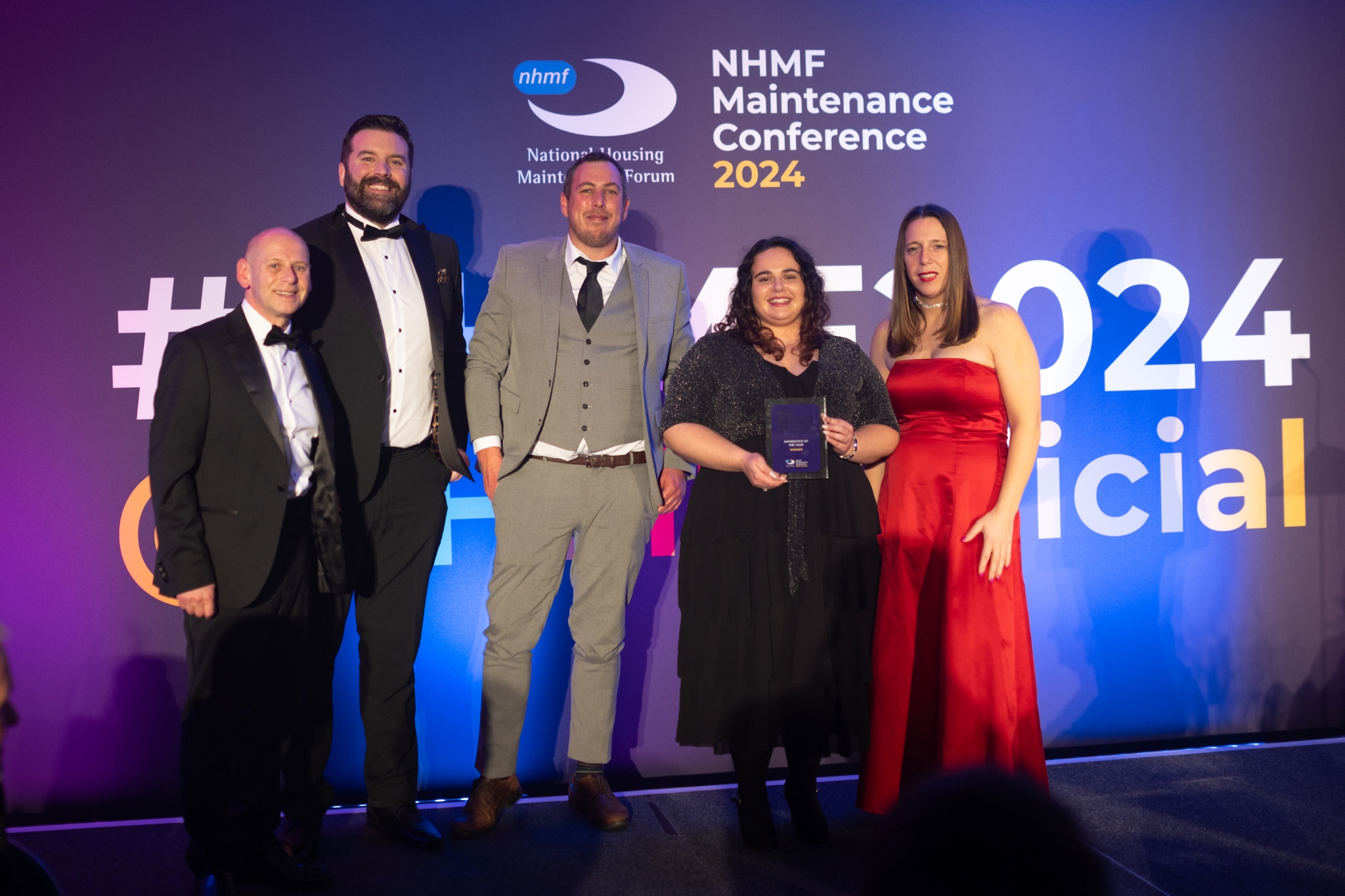NHMF Awards 2023 | Best Customer Impact Winner: Platform Housing Group & Voicescape
Shortlist: Wolverhampton Homes | Barnet Homes & Aico

Judges’ comments
PHG’s winning submission showed a simple and yet effective use of technology to tackle an age-old problem of no-access. With increasing pressure on landlord compliance, anything assisting landlord and customer is welcome. There was a good outcome on no access rates and cost savings of visits. Additionally, the contractor is better able to schedule its work, while the landlord focuses on those cases needing more attention. Customers also seem to benefit by avoiding a calling queue. The technology is easily capable of being replicated and could help reduce carbon footprints and operating costs.
WH explained how this £120m regeneration would benefit customers based on the tenant profile. The combination of physical works to homes (especially high-rise) and a new energy centre using renewable technology should improve tenants’ lives in relation to damp and mould. This project has delivered multiple benefits, including a much-improved estate from a quality and safety aspect, as well as providing social value through training and employment opportunities and more green space. There was good use of technology to communicate with residents. The best bits of previous regeneration projects seem to have been used and the project has been inclusive, given diverse nature of the community.
BH’s initiative is great use of technology to provide continuous monitoring so that residents no longer act as human alarms. The project focusses on one technology stream rather than multiple benefits, even if it becomes commonplace in the sector. BH should be commended for making the investment with a compelling business case. Good potential to be adopted in the industry because the project can be replicated, with using technology the way forwards, especially if the Gateway can be added to existing DMC monitoring.
Platform Housing Group (PHG) & Voicescape
What is the project and what is innovative about the service provided?
Platform Housing Group (PHG) – no-access appointments are a key challenge for social landlords (cost and non-compliance). In 2021, PHG booked gas service appointments using prescriptive methods, where appointments and confirmations were sent to customers via letter and text. This outdated manual process discouraged customers from rebooking if the proposed date was unsuitable. COVID-19 created additional pressures. Some residents did not allow engineers to enter their homes for annual gas safety inspections. PHG employed additional resources to call customers that their gas service was overdue. The cost of no-access visits and the additional resource were unsustainable for PHG, even more so with inflation set to reach 11% by Autumn 2022. To address this, PHG worked with its existing technology partner, Voicescape, to implement Voicescape Compliance a ground-breaking solution designed to help compliance teams meet statutory requirements. It is an automated system of booking, confirming and rescheduling appointments in advance with customers to prevent non-compliance and the cost of no-access visits. Now, if a PHG customer wants to rearrange an appointment, they can simply reply to the automated SMS to be transferred to the relevant available team member and make the arrangement. This means customers no longer need to run through several Interactive Voice Response (IVR) options from the main line and wait in call queues.
What are the measurable benefits to the client, the contractor, the resident, and the neighbourhood?
PHG recognise that compliance and repairs are essential, compulsory services provided by all landlords to ensure the safety and security of their homes. Landlords can be subject to severe penalties for failing to achieve and demonstrate compliance. Voicescape Compliance helps PHG meet statutory obligations to maintain its properties by using digital technology. It engages tenants to augment the booking, confirmation, and re-booking using an automated process. It offers a ‘best of both worlds’ approach to managing compliance by facilitating a prescriptive approach for those tenants who can be flexible to fit a prescribed appointment and providing a more consultative option for tenants needing appointments to fit around their busy lives. This methodology allows the possibility of efficient route planning, reduces the likelihood of missed appointments by consulting the tenant over preferred date and time, and reduces the reliance on manual intervention to call all tenants to schedule appointments. "Voicescape has provided us with a faster, more proactive approach to engaging with our customers and having quality conversations to meet their requirements. Our access rates have increased, allowing us to book appointments that suit the customers whilst also managing our compliance. As a result, Voicescape has made a huge difference to morale within the team and increased our customer engagement using digital technology." Tara Mitchell, Resource Scheduling Manager at PHG.
What are the financial costs and measurable cashable benefits over a defined time period?
PHG has seen incredible results since implementing Voicescape Compliance. First and foremost, it has reduced the rate of no-access appointments for gas servicing (28% to 22%), equating to an immediate saving of £70,478 in just six months across one business function, based on the cost of each no-access appointment. The potential to replicate this across the entire sector, is immense. This result has also enabled the team to focus on more complex cases where customers opt to speak about an issue. The team now has regular reviews with their dedicated Voicescape team to look at results, identify strengths and challenges and benchmark against others before setting objectives to help achieve their goals faster. During these meetings, they noted which calls reached voicemail so that customers had to call back on a designated number. In discussion with the team and the solution was to provide a URL as part of the SMS, enabling the customer to confirm their appointment without calling back. This has increased confirmations received. "Voicescape has allowed us to change the way we schedule our gas servicing appointments. We can now provide a better service for our customers and ultimately reduce our no-access. We can see, in real time, the customers that have confirmed appointments and those who still require contact. Having this level of information is truly changing how we work." Lee Vernalls, Assistant Director of Business Development and Growth at PHG
How relevant is this as an example that might be followed by other organisations?
The PHG model allows organisations to use both a prescriptive and consultative method for repairs and maintenance, automating calls to each tenant, informing them of their scheduled appointment (day and time), while offering tenants a choice – confirm appointment or speak with an advisor to reschedule. Voicescape’s own research has shown that repairs and maintenance is the main driver of tenant dissatisfaction and can have a significant impact on how tenants behave (how they maintain their home, pay rent on time, or fall into arrears). It effectively utilises the innovative technology of Voicescape Compliance and, because of the large number of appointments being processed by the software, a data reintegration cycle allows for daily call outcome information to be fed back into relevant systems internally, e.g., the Housing Management System (HMS). This best practice approach assists with the creation of contact history and can provide evidence of non-engagement by tenants; and it ensures all contacts are recorded as part of effective appointment management. The Voicescape Compliance solution is used effectively in addition to letters and SMS, to reduce no access, increase operating efficiency, and reduce admin costs. The game-changing element of this approach is utilising the power of voice. Using voice technology has delivered transformational results for PHG above, as a more personal way of engaging tenants compared with numerous letters that go unopened. By reducing the risk of no-access appointments, Voicescape Compliance also contributes to reducing the carbon footprint of repairs and maintenance teams incurring mileage from unnecessary journeys. In total, Voicescape now works with over 50 registered social landlords and provides WHG, Places for People, South Tyneside Homes and PHG with its Voicescape Compliance technology. In summary, it is an approach that could be replicated by almost any organisation where no-access appointments are a risk for repairs and maintenance as well as compliance reporting.
Shortlisted schemes
Wolverhampton Homes (WH)
Project and what is innovative?
Wolverhampton is one of the most deprived areas in the country, recently been selected as one of the first two cities to benefit from government Levelling Up funding. Health inequalities and higher than average rates of crime were affecting the lives of residents in an area of the city, Heath Town. Following intense consultation with a wide range of stakeholders, Wolverhampton Council (CWC) launched a £120m transformation programme of Heath Town estate, delivered by WH with its strategic construction partner. They took an innovative approach to project delivery, not only based on building safety and improving the stock but also addressing the main concerns raised by customers as part of initial and ongoing engagement. The new Energy Centre will deliver community district heating through renewable sources, which, together with investment to improve the energy-efficiency of the stock, is making a huge difference to the environmental impact of the entire estate. This will see some of the lowest heating costs associated with this type of construction. High-rise blocks will benefit from new tablet/video style intercom systems, supported by 24/7 CCTV monitoring to improve safety. The system has in-built web links enabling customers to contact WH and receive important updates for each individual block. These will include building safety updates and information, for example, servicing of lifts, cleaning schedules and tenant meetings. The technology is future-proofed to enable links to health and other services including reporting repairs.
Measurable benefits to client, contractor, residents, and neighbourhood?
Wolverhampton’s Heath Town was built in the 1960s (high density of flats and maisonettes) with more than 1200 homes on the estate, the majority let as council housing. Above-ground walkways between blocks meant non-residents could access communal areas and, with the blocks poorly lit, this contributed to an increase in crime and ASB. Property turnover was high and occupancy rate low as the area felt run down and unappealing. Homes were noisy, costly to heat, suffered from damp and mould from thermal bridging in concrete construction. Consultation with residents found safety, security and car parking were their main concerns: 63% wanted more CCTV, 46% wanted more car parking and 44% wanted improvements to external doors and security into blocks including lighting. The main aims of the project were to make Heath Town a better place to live, through:
- High-quality affordable housing to meet current and future needs.
- Well-maintained streets and estates, improved and safer local environment.
- Creating and promoting employment and training opportunities.
- Challenging negative perceptions by promoting an improved image and identity.
Outcomes and benefits for residents/neighbourhood:
- Homes fitted with new energy-saving and noise-reducing double glazing and enhanced fire safety measures, including sprinkler systems.
- CCTV and improved lighting in communal areas
- enhanced feelings of safety and security.
- Cladding to deck access replaced with new system - increasing energy efficiency and helping reduce energy consumption.
- Reduced utility bills with increased thermal comfort, eradicating damp, and mould.
- Additional parking areas, better street lighting and more CCTV coverage.
- Traffic calming measures reducing speed of vehicles through the estate, improving road safety for pedestrians and cyclists.
- New green spaces, play areas and sports pitches well used by families and groups, supporting active healthy lifestyles.
- As of September 2022, Wolverhampton had the highest level of youth unemployment in the country. To address this, social value is embedded in WH contracts, resulting in:
o 137 jobs
o 62 work placements
o 20 apprenticeships/Kickstart placements for local people
o Retaining skills and talent in the city, reducing reliance on benefits.
- Great improvement and looks nice “a really great look for the area. I don’t want to leave.” Miss T, Heath Town resident
Benefits for WH/CWC:
- Construction started on 40 new houses - much-needed additional social housing in city.
- Flat roofs converted to pitched reducing need for ongoing future maintenance.
- Increased occupancy rates (now 99%) and void properties reduced by 76% since 2017 as they are now in much higher demand.
- Average time to let: 612 days (2017) now 36 days (2022).
- Thermal performance of the existing stock improved, reducing energy consumption and costs for customers, and supporting the city’s carbon reduction strategies.
- Regeneration programme has enabled local SME contractors to be employed, helping to keep investment within the city and support Wolverhampton Pound community wealth-building initiative.
Financial costs and measurable cashable benefits?
Overall project cost for Heath Town regeneration is £120m. WH and CWC are collaborating in the Wolverhampton Pound initiative, committed to spending more money within the city. This involves working with local businesses, communities, and the voluntary sector to retain wealth in the city, creating new jobs and more opportunities for residents. It expects to bring £130m to the city’s economy over the next five years, with much of the investment coming through major regeneration projects including this one. As part of the regeneration, every home in Heath Town now has fibre broadband connected. This will facilitate several benefits including fast, reliable internet connection to enhance employment opportunities, online learning, setting up and running a business from home, which will all bring economic benefits to the area. As of September 2022, the Heath Town ward has one of the lowest rates of 18-24 youth unemployment in Wolverhampton, the fourth lowest of the 20 city wards. It will also support older or vulnerable residents to access assisted technologies, reducing reliance on Public Health services and allowing residents to live independently in their own home for longer. |Upgraded heating system allows residents to control energy used in their homes, paying for what they use, previously there was a set weekly heating charge. This allows people to have more control over their finances and will help to drive reduced energy use and the green agenda.
Relevance as an example that might be followed by other organisations?
WH’s teams have engaged with other housing providers and contractors to share best practice and findings from this project. Heath Town regeneration has been a highly complex project from the start, given its age and building design (asbestos). During the early stages, gang activity on the estate required careful management and close partnership working with the police and other organisations, both to keep WH’s teams safe but also to keep the project running on time. It is a highly diverse area, with more than 70 languages spoken. This has required detailed planning and extensive community engagement work to ensure that consultation materials are accessible to all, and two-way dialogue is possible to understand residents’ views, and for them to input and influence decisions about work taking place. Comprehensive resident engagement – drop-in sessions, alongside full meetings, online consultations, and a regular monthly coffee morning, as well as publishing a regular newsletter and disseminating updates and important information through local community groups and the Tenant and Resident Association (TRA). WH staff have been out and about on the estate regularly, speaking to customers to understand their views and concerns. They have also engaged with the Refugee and Migrant Centre to involve them in the consultation, due to the number of languages spoken and different ethnicities on the estate, with material translated into multiple languages. Residents influenced designs and specifications including the colours of cladding, preferred landscaping and car parking areas and security. This “you said, we did” approach created trust and residents have been open about their likes and preferences for other elements of the build which has enabled ongoing changes and positive engagement with those living in Heath Town. Regeneration is about much more than just buildings, and the new construction and building upgrades on Heath Town have kickstarted the revival of the whole area. The estate is a more pleasant place to be, with attractive buildings, the streets are no longer clogged with parked cars and new families have moved in. Residents are proud of where they live and report issues quickly, meaning they can be resolved before they get worse. There is an active TRA and a range of activities and events for adults and young people, keeping people out and about which in turn improves feelings of safety. All these are helping to develop a thriving and vibrant community in Heath Town. “I’ve lived here 12 years and the upgrades are brilliant” Mr J, Heath Town resident
Barnet Homes (BH)
Project and what is innovative?
BH are rolling out Aico's HomeLINK connected Internet of Things (IoT) solution to their 15,000 homes (entire stock to be connected by 2025). This will provide a powerful tool for remote asset management, enabling BH to keep on top of compliance, providing tangible cost savings, and ultimately improving the safety of homes and their occupants. HomeLINK is a connected hardware and software solution tailored to the needs of social landlords. This platform has been used to install and manage connected fire and carbon monoxide (CO) detectors, providing reassurance that such life safety devices are operating as they should be to protect residents. The devices all connect to a single central Gateway in each property, giving landlords a complete overview of property- and stock-level information. Data from these devices on the HomeLINK Portal shows actionable information and alerts (alarm activations, alarm head removals, test button activations, and replacement dates) so landlords can ensure residents’ homes are safe. As of October 2022, 4,000 homes have been connected and provide continuously monitored life safety to an estimated 10,000 residents. The HomeLINK system enables landlords to ensure these homes are fitted to the correct specification, alarms are tested, in date and remain in-situ, and that they are safe, habitable places to live.
Measurable benefits to client, contractor, residents, and neighbourhood?
BH has realised measurable benefits in terms of cost savings, reduced maintenance, and testing visits, and most importantly, resident safety. These will expand as the project grows.
- Cost savings include improved and more efficient compliance reporting, reduced risk of fines, reduced legal expenses, and increased asset lifetime. The connected solution has enabled BH to shift from a “point in time” compliance model to one of continuous monitoring and assurance. Every home and every device connected to the system can be monitored remotely, ensuring ongoing compliance, as well as providing the means to adapt easily to a changing regulatory system. As a result, BH can now produce more accurate, timely, and easy configured reports to demonstrate compliance. It also has an impact on the lifecycle of life safety devices because many devices are replaced well within their usable and compliant lifetime, adding costs on already restricted budgets as well as associated environmental impact. Asset and compliance managers err on side of safety with replacements by aligning with other maintenance visits such as 5-year EICR tests. Aico’s HomeLINK platform provides information about average alarm replacement age, providing asset managers absolute transparency of out of date alarms to greatly reduce the risk of non-compliance while enabling a data-led, strategic, and targeted approach to monitor life safety.
- Fewer maintenance and testing visits with connected HomeLINK system also reduces maintenance costs and scheduling. The ability to remotely monitor and test avoids the need for physical testing visits, as well as ensuring they remain in situ and operational, providing a critical life safety service. Repair visits are also minimised as the issue can be identified and resolved without visiting the property. This reduces costs, frees up time for maintenance teams, and reduces associated disruption to residents’ lives.
- Improved safety of residents and the wider community where connected fire and CO detectors have been installed. Despite being at an early stage of rollout, the introduction of connected CO detectors has already had a life-changing impact on residents. They not only alert when levels of CO are dangerously high, but also report lower levels of CO which could have serious implications for resident safety. These dangerous levels of CO have already been detected in three connected properties in Barnet, saving the lives of residents in the short time the devices have been installed. In some cases, the engineers dispatched to resolve these CO issues have reported some of the highest levels of CO seen in their careers in residential settings. Compatible alarms can be wirelessly interconnected, so when one alarm is triggered, all others sound for improved audibility throughout the property, helping residents respond quickly to any fire or CO-related incident. Installers benefit by eliminating hard-wired cable runs for alarm interconnection, making installation quicker and causing less disruption for residents.
Financial costs and measurable cashable benefits?
BH’s comprehensive 10-year business case identified, a conservative £8.9m in cashable savings to the landlord. Around 60% of these savings were identified from reducing annual checks and property visits, by using remote processes, and a further 15% from maximising asset lifetime, replacing alarms at the end of their compliant life. Additionally, with further safety, compliance and reputation-related savings, this business case identified overall savings of up to £27m. Relative to financial costs, the conservative savings estimate of £8.9m translates into a £2.70 saving for every £1 spent by Barnet.
Relevance as an example that might be followed by other organisations?
BH sees the use of this type of IoT offering enabling landlords to know they are compliant; not simply hope they are. This is an evolution from a cascade of ticked boxes and reports to simply getting alerts when things go wrong and being assured of compliance in real-time at all other times. The plan for BH is to install the gateway cost-effectively in all homes by 2025 as part of ongoing LD2 upgrades. This rollout model is easily replicable and has been seen among many other landlords. A large proportion of social landlords have existing Aico alarms that can be upgraded to connected devices, making the system accessible to many. The life-saving findings from BH and the low-levels of CO present in some of their properties should be a wake-up call for landlords across the sector. A lack of knowledge about the air quality in their homes have significant health implications for their residents. Connected CO detectors and other IoT devices bridge this knowledge gap. BH’s plan is to roll out the new HomeLINK Environmental sensors to at least 100 homes soon. As well as fire safety and compliance, these sensors will be essential in tackling emerging compliance challenges covered in legislation like the Homes Act 2018 (e.g., damp and mould, ventilation, thermal rating, and energy efficiency). They are also effective in measuring whether a home’s indoor environment is appropriate for those with existing health conditions, particularly respiratory illnesses such as asthma and COPD. Poor indoor air quality can exacerbate these problems. As a result, maintaining good indoor air quality can be a real benefit to people who suffer from these conditions. An additional benefit of having the Aico’s Gateway installed across their stock is that it would be very low cost and low effort to deploy these sensors across its 15,000 homes.


